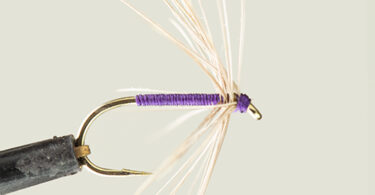
Photograph of James Hunt with a magnificent 43cm grayling
Guiding in Hampshire on the River Test and Itchen can be wonderful in the trout season but there is some excellent fishing to be had in the winter months on some of the very same waters at a quarter of the price. Not all beats are open to grayling but those waters that are can provide some real ‘Mr Crabtree’ fishing. The chances are the weather will be less than ideal, there will be mud or even snow on the bank and the beat will not look manicured. However, even on the coldest days you are likely to see a rising fish or two and hopefully those will be grayling. Somehow, with winter grayling the size of the fish does not seem so important to client or guide. It is the capture of a pure wild fish that gleams silver on the gloomiest of days that brings the angler back time and again. The silver sheen, the magnificent dorsal fin used to fight hard in the current, and most interestingly the smell of the grayling. Believe me, it is not unpleasant at all….they smell of Thyme and there is something magical in a client’s surprise when they experience it. I dread to think what any watching non angler thinks of grown anglers ‘sniffing fish’.
Be under no illusion, grayling are a hard fighting fish and I have noticed time and again that the larger grayling have a tendency to run down stream of the angler. Often it is impossible to stop such a run and then the angler has a difficult and careful fight against the current, the large dorsal is used by the grayling like a sail to give resistance, and often combined with spinning their bodies around, all in an attempt to break free or break off that tippet that you tied confidently at the start of the day convinced that 0.11 fine diameter would catch you more fish.
I always think that the crucial element is to firstly watch the water. This applies on any water in my view and it is amazing how many times you will see a rise at a time or in conditions that you would have predicted there would be none. If the rises are there then a dry fly or emerger pattern is the first choice. However, at some time during the day it is likely you will be fishing a nymph as the rises are not happening and/or you sight grayling clearly feeding at depth. When that is the case then the depth of the nymph as it approaches the grayling is often crucial. I have passed a nymph time and again an inch over a grayling’s head with no response, then adjusted the depth to drop it lower by an inch and taken the fish immediately. The nymph needs to be at the right depth, but also coming towards the grayling in a natural way as if it was being naturally washed downstream. That means without drag speeding it up and also without the nymph catching too much in the gravel on the bottom. We achieve that it a number of ways but fishing New Zealand style ( hanging a nymph under a buoyant dry fly) can give the angler that exact presentation as long as the angler is prepared to experiment to get the correct depth, and be willing to change depth as needed as he/she moves along the river.
When ‘nymphing’ on chalkstreams , whether NZ style or upstream with a single fly or indeed with a dropper I am invariably using beaded flies. Nowadays, tungsten is the number one choice when tying these flies for the weight ratio to size. I like my flies to look proportional, and an oversize bead just doesn’t look correct so at times I want a small fly to get deep quicker than if tied with a conventional bead. I am fishing in waters with currents that are deceptive and it is only when wading that some clients come to appreciate the force of the Test and Itchen even in relatively shallow water. My simple test for speed of decent is to drop the first few feet of leader by hand into the river under my feet at the start and watch the drop of the chosen fly. In chalkstreams this is achievable in the clear water and gives a starting point.
Of course there are times when the fish are feeding on nymphs higher in the water, so just adjust the nymph size and weight to lessen the drop. Invariably the grayling are rising up in the water to intercept the food before returning back to the lies on the gravel. My best advice is to be prepared to change tactics and tippets to get the correct feeding depth. Use fine diameter tippet, preferably Fluorocarbon which in itself sinks at a quicker rate, and carry a selection of nymphs weighted with various weightings. I use Pheasant Tail nymphs regularly throughout the season, and often the best results are with size 18 and 16 hooks. Takes seem to come more confidently to the smaller sizes and so if the going gets tough I am invariably changing to a smaller fly size. Hares Ear nymphs are also a favourite and can be tied with variations in bead size to suit most conditions. I also tie some Caddis patterns in larger sizes using large 3.5 and 4mm tungsten beads. These can be very effective in their own right but of course they can be fished as a sacrificial fly on the point to get your tiny PTN down to the fish. Also, be armed with shrimp patterns for grayling as the shrimp makes up a high proportion of their diet.
The combinations are many but the best way is to go out and have some ‘Winter madness’.




